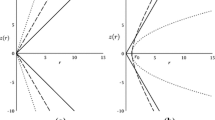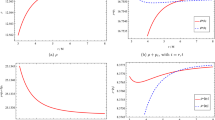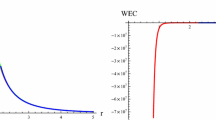Abstract
We develop a general method for constructing curved traversable wormholes in (2+1)-dimensional spacetime, by generating surfaces of revolution around smooth curves. Application of this method to a straight line gives the usual spherically symmetric wormholes. The physics behind (2+1)-d curved traversable wormholes is discussed based on solutions to the Einstein field equations when the tidal force is zero. The Einstein field equations are found to reduce to one equation whereby the mass-energy density varies linearly with the Ricci scalar, which signifies that our (2+1)-d curved traversable wormholes are supported by dust of ordinary and exotic matter without radial tension nor lateral pressure. With this, two examples of (2+1)-d curved traversable wormholes: the helical wormhole and the catenary wormhole, are constructed and we show that there exist geodesics through them supported by non-exotic matter. This general method is applicable to our (3+1)-d spacetime.






Similar content being viewed by others
References
Morris, M.S., Thorne, K.S.: Am. J. Phys. 56(5), 395 (1988). doi:10.1119/1.15620. http://link.aip.org/link/?AJP/56/395/1
Visser, M.: Lorentzian Wormholes: from Einstein to Hawking. American Institute of Physics, New York (1996)
Visser, M., Kar, S., Dadhich, N.: Phys. Rev. Lett. 90, 201102 (2003). doi:10.1103/PhysRevLett.90.201102
Friedman, J.L., Schleich, K., Witt, D.M.: Phys. Rev. Lett. 71, 1486 (1993). doi:10.1103/PhysRevLett.71.1486
Hochberg, D., Visser, M.: Phys. Rev. Lett. 81, 746 (1998). doi:10.1103/PhysRevLett.81.746
Kar, S., Dadhich, N., Visser, M.: Pra. J. Phys. 63(4, SI), 859 (2004). doi:10.1007/BF02705207. 5th International Conference on Gravitation and Cosmology (ICGC-2004), Cochin University of Science and Technology Kochi, JAPAN, JAN 05–10, 2004
Roman, T.A.: Phys. Rev. D 47(4), 1370 (1993). doi:10.1103/PhysRevD.47.1370
Visser, M.: Nucl. Phys. B 328(1), 203 (1989). doi:10.1016/0550-3213(89)90100-4
Kim, S.W.: Phys. Lett. A 166(1), 13 (1992). doi:10.1016/0375-9601(92)90866-K
Delgaty, M.S.R., Mann, R.B.: Int. J. Mod. Phys. D 4(2), 231 (1995). doi:10.1142/S021827189500017X
Lemos, J.P.S., Lobo, F.S.N., de Oliveira, S.Q.: Phys. Rev. D 68(6), 103007 (2003). doi:10.1103/PhysRevD.68.064004
Sushkov, S.: Phys. Rev. D 71(4), 043520 (2005). doi:10.1103/PhysRevD.71.043520
Lobo, F.S.N.: Phys. Rev. D 71(8), 084011 (2005). doi:10.1103/PhysRevD.71.084011
Lobo, F.S.N.: Phys. Rev. D 71, 124022 (2005). doi:10.1103/PhysRevD.71.124022
Rahaman, F., Kalam, M., Sarker, M., Gayen, K.: Phys. Lett. B 633(23), 161 (2006). doi:10.1016/j.physletb.2005.11.080. http://www.sciencedirect.com/science/article/pii/S037026930501748X
Lobo, F.: Phys. Rev. D 71(12), 124022 (2005). doi:10.1103/PhysRevD.71.124022
Visser, M.: Phys. Rev. D 39(10), 3182 (1989). doi:10.1103/PhysRevD.39.3182
Misner, C.W., Thorne, K.S., Wheeler, J.A.: Gravitation. Freeman, San Francisco (1973)
Blau, S.K., Guendelman, E.I., Guth, A.H.: Phys. Rev. D 35, 1747 (1987). doi:10.1103/PhysRevD.35.1747
Teo, E.: Phys. Rev. D 58(2), 024014 (1998). doi:10.1103/PhysRevD.58.024014
Kuhfittig, P.K.F.: Phys. Rev. D 67, 064015 (2003). doi:10.1103/PhysRevD.67.064015
Gonz{\’a}lez-Diaz, P.F.: Phys. Rev. D 54, 6122 (1996). doi:10.1103/PhysRevD.54.6122
Kuhfittig, P.K.F.: Phys. Rev. D 71, 104007 (2005). doi:10.1103/PhysRevD.71.104007
Bronnikov, K.A., Lemos, J.P.S.: Phys. Rev. D 79, 104019 (2009). doi:10.1103/PhysRevD.79.104019
Gott, J., Alpert, M.: Gen. Relativ. Gravit. 16, 243 (1984). doi:10.1007/BF00762539
Headrick, M.P., Gott, J.R.: Phys. Rev. D 50, 7244 (1994). doi:10.1103/PhysRevD.50.7244
Perry, G., Mann, R.: Gen. Relativ. Gravit. 24, 305 (1992). doi:10.1007/BF00760232
Kim, S.W., Lee, H.J., Kim, S.K., Yang, J.: Phys. Lett. A 183(56), 359 (1993). doi:10.1016/0375-9601(93)90588-Q. http://www.sciencedirect.com/science/article/pii/037596019390588Q
Kim, W.T., Oh, J.J., Yoon, M.S.: Phys. Rev. D 70, 044006 (2004). doi:10.1103/PhysRevD.70.044006
Rahaman, F., Kalam, M., Bhui, B.C., Chakraborty, S.: Phys. Scripta 76(1), 56 (2007). doi:10.1088/0031-8949/76/1/010
Rubio, E.A.L.: Rev. Col. Fis. 40, 222 (2008)
Jamil, M., Farooq, M.U.: Int. J. Theor. Phys. 49(4), 835 (2010). doi:10.1007/s10773-010-0263-z
Pressley, A.N.: Elementary Differential Geometry. Springer, New York (2008)
Wheeler, J.A.: Phys. Rev. 97, 511 (1955). doi:10.1103/PhysRev.97.511
Visser, M.: Phys. Rev. D 43, 402 (1991). doi:10.1103/PhysRevD.43.402
Visser, M.: Mod. Phys. Lett. A 6(29), 2663 (1991). doi:10.1142/S0217732391003109
Casimir, H.B.G.: Proc. Kon. Ned. Akad. Wetensch. B 51, 793 (1948)
Lamoreaux, S.K.: Phys. Rev. Lett. 78, 5 (1997). doi:10.1103/PhysRevLett.78.5
Mohideen, U., Roy, A.: Phys. Rev. Lett. 81, 4549 (1998). doi:10.1103/PhysRevLett.81.4549
Acknowledgments
We would like to express our sincere appreciation to Sampsa Vihonen from University of Jyväskylä (JYU), Sai Sunku Swaroop from Nanyang Technological University (NTU) and Hoai Nguyen Huynh (NTU) for their efforts in our discussions as well as their critical comments which have provided great assistance. Special thanks is directed to the reviewers whose comments have led to an enrichment of this paper. Finally, we would like to mention that Andrew Kricker and Fedor Duzhin from the Division of Mathematical Sciences, NTU have been helpful with some mathematical discussions.
Author information
Authors and Affiliations
Corresponding author
Appendix: some proofs
Appendix: some proofs
1.1 Proof of metric for surface of revolution generated around plane curves being free of spatial cross-term
Consider a unit-speed plane curve \({\varvec{\psi }}(v)=(f(v),g(v),0)\) where \(f^{\prime }(v)\) and \(g^{\prime }(v)\) (recall that prime denotes derivative with respect to \(v\)) are not simultaneously zero. A curve is unit-speed if its tangent vector has unit length, so that \(f^{\prime }(v)^2+g^{\prime }(v)^2=1\). It is a theorem in elementary differential geometry that any smooth (or regular) curve can be reparametrised to be unit-speed [33], so it is sufficient to just consider unit-speed curves.
According to the method described in Sect. 2, the two orthonormal vectors are \(\mathbf{{n}}(v)=(-g^{\prime }(v),f^{\prime }(v),0)\) and \(\mathbf{{b}}(v)=(0,0,1)\). Hence the surface of revolution around \({\varvec{\psi }}(v)\) is
Then, the partial derivatives of \({\varvec{\sigma }}\) are
With this,
From the unit-speed condition, the first term in \(g_{uv}\) vanishes. Differentiating the unit-speed condition with respect to \(v\) gives \(f^{\prime }(v)f^{\prime \prime }(v)+g^{\prime }(v)g^{\prime \prime }(v)=0\), so that the second term also vanishes. This completes the proof.
In addition, note that \(g_{uu}=Z(v)^2\), and also that \(g_{vv}\) is in general a function of both spatial coordinates \(u\) and \(v\).
1.2 Proof of the 3-manifold of revolution around a straight line being spherically symmetric
A 3-manifold is said to be spherically symmetric if when expressed in spherical coordinates, its metric takes the form
where \(A(r)\) is some function of the radial coordinate [18].
Consider the straight line \(\mathbf{l}(v)=(0,0,0,z(v))\) embedded in a 4-d Euclidean space. Following the technique described in Sect. 5 and taking the three orthonormal vectors mutually perpendicular to \(\mathbf{l}(v)\) to be the directions along the other three coordinate axes \(\mathbf{e}_1, \mathbf{e}_2\) and \(\mathbf{e}_3\), the 3-manifold of revolution around \(\mathbf{l}(v)\) is
Then, the partial derivatives of \({\varvec{\tau }}\) (prime in this section denotes derivative with respect to \(w\)) are
The non-zero components of the metric tensor would be
and so
A metric of this form can be considered to be spherically symmetric. Nevertheless, we shall make this explicit by expressing it in the form in Eq. (59). To do this, we will make the following reparametrisation \(v=Z^{-1}(r), u=\theta \) and \(w=\phi \). Under this reparametrisation, Eq. (60) becomes
The metric would then be
The proof for an n-manifold of revolution around a straight line is similar.
Rights and permissions
About this article
Cite this article
Saw, VL., Chew, L.Y. A general method for constructing curved traversable wormholes in (2+1)-dimensional spacetime. Gen Relativ Gravit 44, 2989–3007 (2012). https://doi.org/10.1007/s10714-012-1435-3
Received:
Accepted:
Published:
Issue Date:
DOI: https://doi.org/10.1007/s10714-012-1435-3




